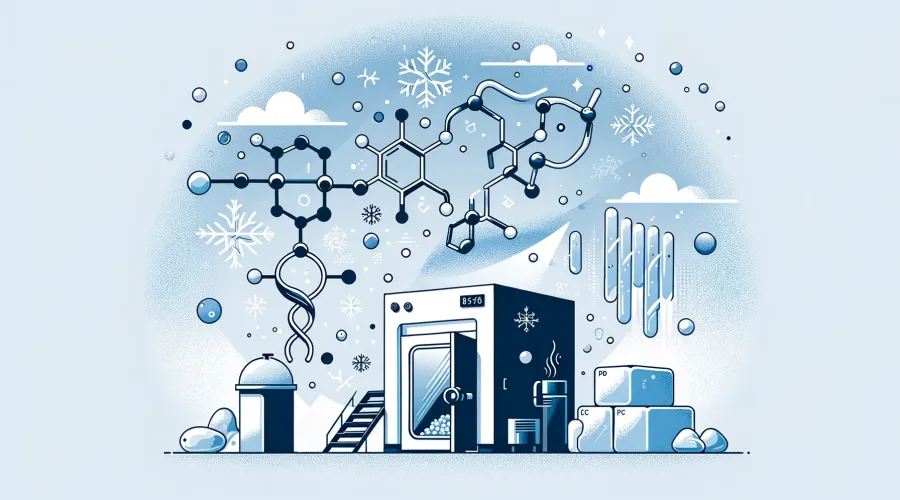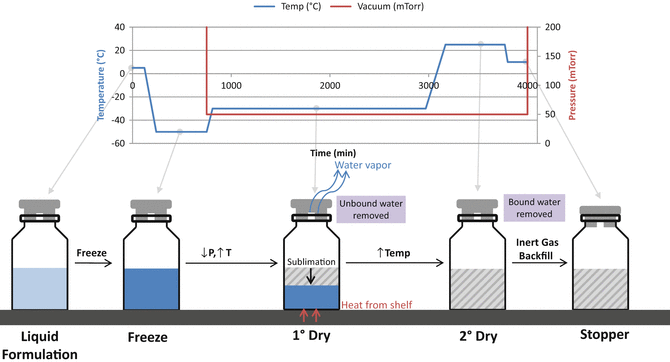
Introduction
Keeping these tiny yet powerful molecules stable and intact in peptide research is crucial. That's where Lyophilisation, also known as freeze-drying, comes in. This fascinating process is a game-changer, ensuring that peptides last longer while keeping their essential properties unchanged.
What is Lyophilisation?
Think of Lyophilisation as a unique drying method. It's like preparing food for a space mission: you freeze it, then carefully remove all the ice without turning it into water. This method keeps the peptides dry and stable, perfect for long-term storage and easy transportation.
Why Lyophilise Peptides?
- Stability: In liquid, peptides can break down quickly. Freeze drying pulls out the water and keeps them stable.
- Longevity: Like food in your freezer, freeze-dried peptides last much longer without losing their effectiveness.
- Transportation and Storage: These dry peptides are resilient to temperature changes, making them easier to move and store.
- Ease of Use: Scientists can easily mix them back into a liquid in precise amounts when it's time to use them.
The Lyophilisation Process:
- Freezing: First, we freeze the peptides, turning all the water into ice.
- Primary Drying (Sublimation): Then, we put them in a vacuum, where the ice turns directly into gas and leaves the peptides dry, removing about 95% of the water.
- Secondary Drying: Lastly, we gently remove any leftover water.
Enhancing Preservation with Nitrogen Flushing
After freeze-drying, we give peptides a particular nitrogen 'bath.' Nitrogen gas replaces the air in the packaging. Why nitrogen? It's a gentle gas that doesn't react with peptides, keeping them fresh and stable.
Benefits of Nitrogen Flushing:
- Longer Shelf Life: This creates the perfect environment for peptides to stay fresh.
- Protection Against Oxidation: Keeps peptides safe from air-related damage during storage and transit.
- Quality Maintenance: Peptides remain in top-notch condition until they're ready to be used.
A Note on Packaging:
Once sealed with nitrogen, these peptide vials may release some gas. The nitrogen flush is crucial because it affects how strong the vacuum is inside, which matters when reconstituting the peptides later. It's important to note that not all peptides will have a strong vacuum. In some cases, a peptide may have pressure inside the vial or a balanced pressure. This variability is normal and depends on the specific peptide and the conditions during sealing.
Quality and Purity:
We ensure each batch of peptides is pure and structurally sound using high-tech methods like High-Performance Liquid Chromatography (HPLC) and Mass Spectrometry (MS).
Conclusion:
Especially when combined with nitrogen flushing, Lyophilisation is essential in peptide research. It's all about keeping these powerful molecules stable, safe, and ready for use.

Glossary of Key Terms
- Lyophilisation (Freeze-Drying)
- A process used to dry materials by freezing them and then reducing the surrounding pressure to allow the frozen water in the material to change from solid to gas.
- Peptide
- Short chains of amino acids, which are the building blocks of proteins. Peptides are smaller than proteins and are used in various research and therapeutic applications.
- Stability
- In the context of peptides, stability refers to the ability of a peptide to maintain its chemical structure and biological activity over time.
- Sublimation
- The transition of a substance directly from the solid to the gas phase, without passing through the liquid phase. This is a key step in Lyophilisation.
- Nitrogen Flushing
- A process where nitrogen gas is used to replace the oxygen in the packaging of lyophilised peptides to enhance their preservation.
- High-Performance Liquid Chromatography (HPLC)
- A technique in analytical chemistry used to separate, identify, and quantify components in a mixture.
- Mass Spectrometry (MS)
- An analytical technique that measures the mass-to-charge ratio of ions to identify and quantify molecules in a sample.
- Primary Drying
- The initial phase in the Lyophilisation process, where most of the water (or solvent) is removed from the frozen product through sublimation.
- Secondary Drying
- The final phase of Lyophilisation, where the remaining bound water (or solvent) is removed, typically involving a slight increase in temperature.
- Vacuum
- A space devoid of matter, used in the Lyophilisation process to facilitate the sublimation of ice into water vapor.
- Reconstitution
- The process of adding a solvent (like water) to a lyophilised peptide to return it to a liquid form for use.
